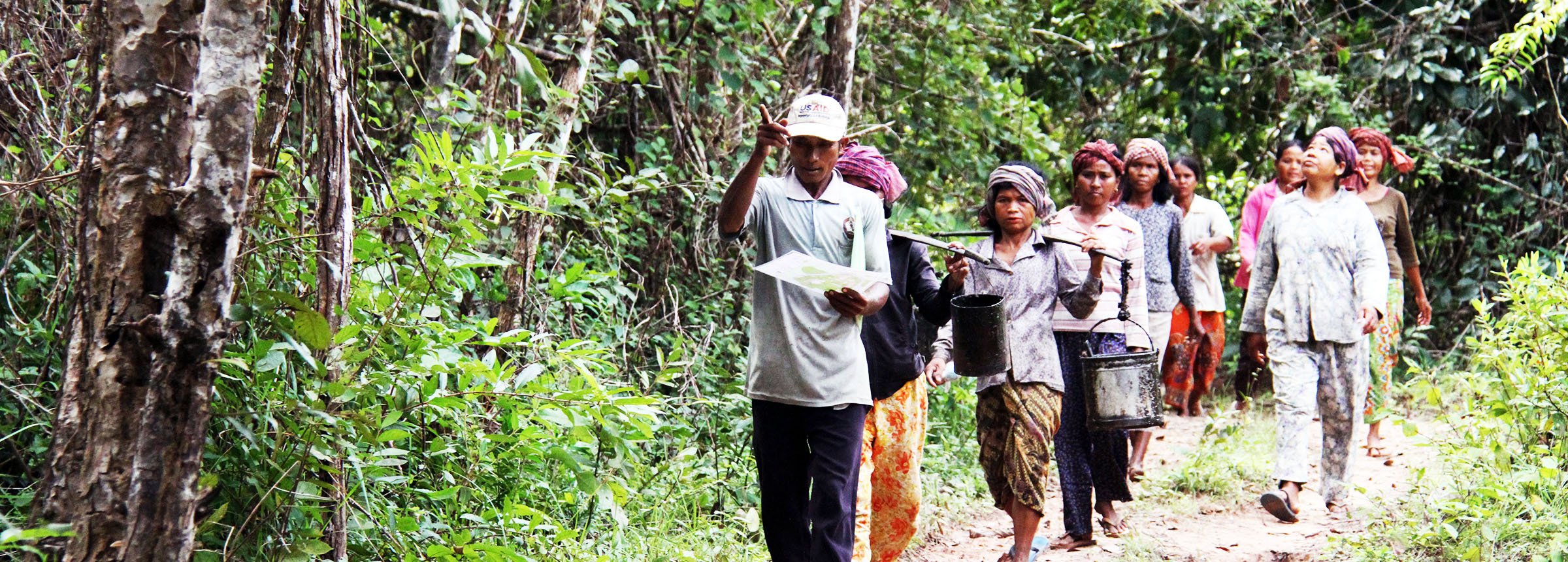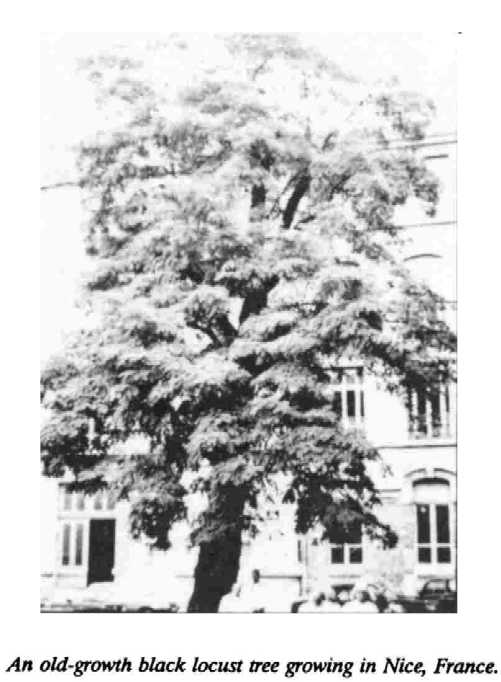
Robinia pseudoacacia: Temperate Legume Tree with Worldwide Potential
NFTA 91-03, July 1991
A quick guide to useful nitrogen fixing trees from around the world
Very few nitrogen fixing trees are temperate, and very few of these are legumes. The genus Robinia, with four species native to temperate regions of North America, is noteworthy for an ability to tolerate severe frosts. Robinia pseudoacacia L, or black locust (family Leguminosae, subfamily Papilionoideae), is among the few leguminous NFTs adapted to frost-prone areas. It is also adaptable to environmental extremes such as drought, air pollutants, and high light intensities (Hanover 1989). Rapid growth, dense wood, and N2 fixing ability make it ideal for colonizing degraded sites.
 BOTANY
BOTANY
Black locust is a medium-sized tree reaching 15-35 m in height and 0.3-1.0 m in diameter. Long (20- 45 cm) pinnate leaves consist of 5-33 small oval, alternate leaflets. Sharp spines are found at the nodes of young branches but are rare on mature wood. The smooth bark becomes reddish-brown and deeply furrowed with age. White to pink, fragrant flowers in 10-25 cm long, hanging racemes appear in early summer soon after the leaves. The closed flowers require bees to force petals open for cross-pollination. The small pods contain 4-8 hard-coated seeds which can persist in the soil for many years. Seed crops occur every 1-2 years beginning at age 3; pods open on the tree in winter and early spring. Although it can occur as a polyploid, it is primarily diploid (N = 10).
ECOLOGY
Black locust is native to regions with 1,000- 1,500 mm annual rainfall, yet it is drought-tolerant and survives on as little as 400 mm. Its natural distribution includes the Appalachian and Ozark mountains of the eastern US between 35o-43o N latitudes. It occurs on upland sites in hardwood forests with black oak, red oak, chestnut oak, pigaut hickory, yellow poplar, maple, and with ash along streams. In the northern part of its range at 800 m elevation it occurs with Picea rubra and Acer saccharum (Keresztezi 1988b).
First introduced to France and England in 1600, black locust has become increasingly important throughout Europe and in parts of Asia (Keresnesi 1988a). It now covers 18% of Hungary’s forested areas. It is grown in temperate and subtropical regions in the US, Europe, New Zealand, India, China, and Korea. It has even been grown at higher, cooler elevations in the tropics (e.g. in Java). Trees tolerate temperatures from 40o C to –35o C. It is found on a variety of soils with pHs of 4.6 to 8.2, but grows best in calcareous, well-drained loams. Trees do not tolerate water-logging. Extremely intolerant of shade, the trees are pioneers on disturbed soils or burned sites, often reproducing prolifically from root sprouts (Fowells 1965). Black locust dominates early forest regeneration in many native forest stands where it occurs (Boring and Swank 1984).
SILVICULTURE
Propagation: Black locust seeds (35,000-50,000 seeds/kg) require scarification for good germination. Treatment with concentrated sulfuric acid for 20-50 min is most effective. Seeds can also be nicked, soaked in boiling water for several minutes, or washed in aerated cold water for 2-3 days.
Trees sucker readily from roots and also graft easily. They can be propagated, with difficulty, from hardwood cuttings (15-30 cm long and 1-2 cm diameter) collected in winter or early spring. Treatment with indole acetic acid improves rooting. The tree responds well to tissue culture and has been mass propagated by this method. In nursery culture black locust is either direct seeded or root sections (5-8 cm long) planted. Robinia pseudoacacia seed is available from NFTA; improved seed is available from James Hanover (MSU).
Growth and yield: The species has one of the highest net photosynthetic rates among woody plants. Black locust grows rapidly, especially when young. Trees can reach 3 m tall in one growing season and average 0.5-1.5 m height and 0.2-2 cm diameter growth per year. Trees attained 12 m ht in 10 yrs and 20 m ht in 25 yrs in Kashmir (Singh 1982), and 26 m ht and 27 cm diameter in 40 yrs in the US. intensive management combined with genetic selection gave experimental dry weight yields up to 40 t/ha/yr under short rotation. On fertile sites it can yield more than 14 m3/ha/yr (9.5 t/ha/yr.) on a 40-yr rotation with only moderate management. On poor sites, such as strip mines in the US, oven-dry biomass yields range from 3.1 to 3.7 t/ha/yr. Timber volume in a 20-yr-old stand ranged from 63 to 144 t/ha (Keresztesi 1988a), and aboveground biomass in a 38-yr-old native mixed forest stand in N. Carolina, US, was 330 t/ha (Boring and Swank 1984). Fuelwood plantations in S. Korea coppice readily and are lopped annually for fuel (NAS 1983).
TREE IMPROVEMENT
R. pseudoacacia has been cultivated for over 350 years. Natural variation in numerous traits has often been observed and many cultivators described. Surles et al. (1989) showed a high degree of polymorphism (71%) for 18 enzyme systems in black locust. Most of the diversity resided within seed sources with low geographic variation. Cultivators vary in crown and stem form, growth rate, growth habit (upright vs. prostrate), leaf shape, thorniness, flowering characteristics, and phenology. Clonal selection, early pruning, and close spacing have been effective means of producing straight-stemmed black locust in plantations, especially in Eastern Europe. Comprehensive germplasm collections and plantings for provenance tests were begun in 1982 at Mich. State Univ. Efforts in crossbreeding are under way to improve the tree for growth rate, borer resistance, stem form, thorn-lessness, or other traits (Hanover et al. 1989). In Hungary, a large array of tall clones is in commercial use (Keresztesi 1983), based on seeds from trees of “shipmast locust” originating from Long Island in New York State.
USES
Wood: Black locust wood is strong and hard with a specific gravity of 0.68, yet it has the lowest shrinkage value of US domestic woods. The wood makes a good charcoal. Wood energy yield is typical of temperate broadleaf trees, about 19.44 x 106 J/kg (Stringer and Carpenter 1986). The beautiful light to dark brown wood is used to make paneling, siding, flooring, furniture, boat building (substitute for teak), decking, vineyard or nursery props, fruit boxes, and pallets. It is also a preferred wood for pulp production. Black locust wood is highly resistant to rot (Smith et al. 1989).
Fodder: Black locust has become an important tree in the Himalayas where it is heavily lopped for fodder (Singh 1982). Leaves have a crude protein content of 24%. However, tannins and lectin proteins found in leaves and inner bark can interfere with digestion in ruminants and in nonruminants (Harris et al. 1984). Tannin levels are high in young leaves but decrease as leaves mature.
Honey: Bees harvest Robinia nectar to produce a honey regarded as one of the world’s finest. Tree improvement specifically for late flowering and high nectar sugar content is ongoing in Hungary and the US.
Other: The tree is used extensively to rehabilitate surface mine tailings in the US. In Hungary, black locust is often grown for wood on small private farms (Keresztesi 1986). A dense growth habit makes black locust suitable for windbreaks, a use most common in China. Black locust may even prove useful for alley cropping in temperate climates. Researchers at the Rodale Research Center in Pennsylvania are experimenting with intercropping black locust with vegetables. Numerous reports indicate the beneficial effect of this NFT to associated plants through improved soil fertility. Mixed plantings of black locust and conifers, however, can lead to reduced growth or death of the slower growing conifers because of shading and over-topping.
PESTS AND PROBLEMS
The most serious pest to black locust in the US is the locust borer, Megacyllene robiniae (Forster). There is some evidence for genetic resistance to the borer. Another insect confined to trees in the US is the locust twig borer, Ecdytolopha insiticiana (Zeller). Aphids, Nectria cankers, leaf miners, and Rimosus heart rot also affect the tree (Hoffard and Anderson 1982). Its propensity to root spout aggressively can also cause problems.
RHIZOBIUM
Robinia is fairly specific in its Rhizobium requirements. Although it will form nodules with a variety of exotic strains, for effective N-fixation, strains from native trees work best. Newly introduced trees require inoculation; inoculum may be gotten from the soil of black locust stands, or from NFTA. The tree’s fine roots are also colonized by VA mycorrhizae.
PRINCIPAL REFERENCES:
Boring, L.R. and W.T. Swank. 1984. The role of black locust (Robinia pseudoacacia) in forest succession. J. Ecol. 72:749- 766.
Fowells, HA. (ed.). 1965. Silvics of Forest Trees of the United States. USDA, Forest Service, Agric. Handbook No. 271.
Hanover, ].W. 1989. Physiological genetics of black locust (Robinia pseudoacacia L.): A model multipurpose tree species. Proc. Conf. on Fast Growing Nitrogen Fixing Trees, 1989, Marburg, W. Germany.
Hanover, J.W., T. Mebrahtu, and P. Bloese. 1989. Genetic improvement of black locust: A prime agroforestry species. Proc. First Conf. on Agroforestry in N. America, Aug. 1989, Guelph, Ontario, Canada.
Hoffard, W.H. and R.L. Anderson. 1982. A guide to common insects, diseases, and other problems of black locust. USDA Dept. Agric. Forestry Rep. SA-FR-19.
Keresztesi, B. (ed). 1988a. The Black Locust. Akademiai Kiado, Budapest, Hungary.
Keresztesi, B. 1988b. Black locust: ‘Me tree of agriculture. Outlook on Agric. (Great Britain) 17(2):77-85.
Singh, R.V. 1982. Fodder Trees of India. Oxford and IBA Public. Co., 66 Janpath, New Delhi 110001, India.
Stringer, J.W. and S.B. Carpenter. 1986. Energy yield of black locust biomass fuel. For. Sci. 32:1049-1057.
Surles, S.E., J.L. Hamrick, and B.C. Bongarten. 1989. Allozyme variation in black locust (Robinia pseudoacacia). Can. J. For. Res. 19:471479.
Written by James W. Hanover and Tesfai Mebrahtu, Department of Forestry, Michigan State University, 126 Natural Resources, Fast Lansing, Michigan 48824-1222, with contributions from the NFRA staff.
A publication of the Forest, Farm, and Community Tree Network (FACT Net)
